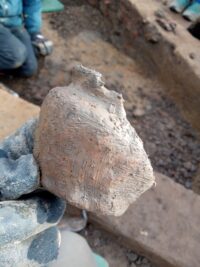 Archaeologists have found the remains of a massive Roman-era pottery production facility in Wrzępia, southern Poland. A geophysical survey of the five-hectare site found approximately 130 furnaces, which makes it by far the largest pottery production site of its type in Poland and one of the largest in Eastern Europe. The pottery was in operation from the late 2nd/early 3rd century to the 5th.
Archaeologists have found the remains of a massive Roman-era pottery production facility in Wrzępia, southern Poland. A geophysical survey of the five-hectare site found approximately 130 furnaces, which makes it by far the largest pottery production site of its type in Poland and one of the largest in Eastern Europe. The pottery was in operation from the late 2nd/early 3rd century to the 5th.
Two of the kilns have now been excavated, and the fragments found indicate the facility specialized in one type of pottery.
“Our research shows that only storage vessels with characteristic thickened spouts were produced there. These were large vessels up to 50 cm in diameter and about 70 cm high. The vessels were most likely used for storage – e.g. food. type of vessels where they probably played the role of peculiar pantries “- explains archaeologist Jan Bulas. […]
Dishes fired in open furnaces were made with the use of a potter’s wheel, which became popular in this area at that time.
Veterans of the legions who settled beyond the Roman limes brought Roman technology (like the pottery wheel), craftsmanship and consumer goods which were adopted by the Germanic peoples, particularly by the elite who increasingly lived a Romanized lifestyle. We know from coin finds that there was a significant flow of Roman money to what is now Lesser Poland in the late 2nd, early 3rd century A.D. After a dip in the late 3rd century, transfers of Roman coinage picked back up in the 4th before coming to a halt in the middle of the 5th century.
 This coincides roughly with the dates of the Wrzępia facility. Large-scale production facilities like the pottery attest to how Roman technology and mass-production of consumer goods spread outside the boundary of the Empire. The kilns were a local operation run by the Vandals who inhabited the area. Its large size and specialized production shows there was a thriving, active, complex economy in the area.
This coincides roughly with the dates of the Wrzępia facility. Large-scale production facilities like the pottery attest to how Roman technology and mass-production of consumer goods spread outside the boundary of the Empire. The kilns were a local operation run by the Vandals who inhabited the area. Its large size and specialized production shows there was a thriving, active, complex economy in the area.
Excavation of the site has ended for now. Researchers will focus on cleaning, conserving and studying the artifacts they’ve recovered so far and hope to return next year to excavate as many of the 130 kilns as possible.